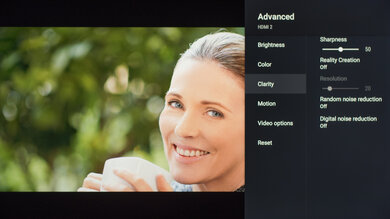- Table of Contents
- Top
- General Settings
- Motion Settings
- Gaming
- White Balance
- Discussions
We used the following calibration settings to review the Sony 55" X750H (KD-55X750H), and we expect them to be valid for the 65" model (KD-65X750H), and the 75" model (KD-75X750H). These settings should apply to most types of content, except for gaming or use as a PC monitor, which require a few additional changes, listed below.
General Settings
Eco Settings
One of the first things we did was disable the Power Saving mode, as we don't want the TV to adjust the image during testing.
SDR
For SDR content, there are six preset picture modes. We recommend choosing the 'Custom' Picture Mode, as it is the most accurate one out of the box, and allows for the most customization. We recommend leaving the Contrast to '90,' Gamma at '0,' and the Black Level at '50.' For our calibration, Black Adjust and Adv. Contrast Enhancer were both disabled, but you should adjust these to your liking.
You should adjust the Brightness to your specific viewing conditions. Changing the brightness does not have any impact on the overall picture quality.
Clarity
In the Clarity tab, we left Sharpness to the default value of '50,' which is the neutral setting. Reality Creation was left disabled, but you can enable it when watching lower resolution content, as it can help to improve the image quality. Random Noise Reduction and Digital Noise Reduction were also left disabled, but they can help improve the image quality of low quality videos. We don't recommend leaving them enabled, as they can cause a loss of fine details in higher quality content.
HDR
HDR is automatically enabled for the native apps. When you start playing HDR content, a small HDR icon appears in the picture settings menu. Once you start playing HDR content, some of the settings change automatically, including the Brightness, which increases to 'Max.' We recommend leaving these settings to their default settings in HDR.
For HDR to work from external devices, the Enhanced Format option usually has to be enabled from the 'HDMI signal format' menu for the input you are using. Older devices may have compatibility issues if this option is left enabled, so it is recommended to only enable this setting for devices that require it.
If you find HDR content too dim, you can make it brighter by using the 'HDR Custom' Picture Mode, with the Color Temperature set to 'Cool', Brightness set to maximum, and Color set to '50'.
Motion Settings
Sony TVs usually feature great, highly customizable motion features, and the X750H is no exception. Although we disable most motion enhancing functions for most of our tests, you should adjust these to whatever looks best for you. Some settings, like motion interpolation settings, may need to be adjusted depending on the specific content you are watching. Do note that these settings aren't working properly at the time of writing and will likely be fixed via a firmware update.
Motion Interpolation
Although we usually leave these settings disabled during testing, you should adjust the settings in the Motion tab to your liking, as different people prefer different levels of motion interpolation. If you want to enable motion interpolation, set Motionflow to 'custom,' and adjust the Smoothness slider. Most of these settings will need to be adjusted depending on the specific content you are watching.
The Clearness slider adjusts the X750H's black frame insertion (BFI) feature.
Judder Settings
The Sony X750H can only remove judder from 24p sources. For a native 24p signal, like from a Blu-ray player, no additional motion settings are required.
Gaming
From the base SDR and HDR settings, very few changes are required for a great gaming experience. When you start gaming, it is best to switch to the 'Game' Picture Mode, to get the lowest input lag, and use the recommended settings for SDR or HDR. For HDR gaming, it is important to make sure that HDMI Enhanced Format is enabled for the input you are using.
PC Gaming
Unlike TVs from most other brands, no special settings are required for PC use on the X750H. Just make sure you are using either the 'Game,' or 'Graphics' Picture Mode, and that HDMI Enhanced Format is enabled for the input you are using. Unfortunately, the X750H can't display proper chroma 4:4:4, but this could be a bug.
Screen Settings
When watching lower resolution content, the upscaling method may need to be adjusted depending on the specific format. The screen position and aspect ratio can be adjusted from the Screen page on each input.
White Balance Settings
The following are the results of the white balance and colorspace calibration on our unit. They are provided for reference, and should not be copied as the calibration values vary per individual unit even for the same model and same size as the TV we reviewed due to manufacturing tolerances. If you want to try them you will need to enter all values shown, as all of them are active at the same time. If you end up with worse picture quality, simply reset them to the default values.






























































